The Oprah Show's Greatest Lessons

In 1988, Oprah learned one invaluable lesson the hard way when she taped a show with a panel of white supremacists. She says her producers knew it would be edgy, controversial and likely get huge ratings. More importantly, Oprah and her team thought they could expose the white supremacists ignorance and confront their hatred of black people right on national television.
The plan backfired on them when the panel came in with their own agenda. After promoting violence and making several offensive comments, the white supremacists walked off the stage.
After the show, Oprah says she felt unsettled and had a strong epiphany. "In the end, we gave a bunch of racists an hour-long platform to spread their message of hate and evil. That taping changed the way I thought about TV and how it should be used," she says. "I made a conscious decision to never again use this platform to put that kind of energy out into the world."
Today, two of the white supremacists who were on the show that day in 1988 have been invited back to The Oprah Show. This time, they have a much different message. See what they have to say today.
The plan backfired on them when the panel came in with their own agenda. After promoting violence and making several offensive comments, the white supremacists walked off the stage.
After the show, Oprah says she felt unsettled and had a strong epiphany. "In the end, we gave a bunch of racists an hour-long platform to spread their message of hate and evil. That taping changed the way I thought about TV and how it should be used," she says. "I made a conscious decision to never again use this platform to put that kind of energy out into the world."
Today, two of the white supremacists who were on the show that day in 1988 have been invited back to The Oprah Show. This time, they have a much different message. See what they have to say today.

Another profound moment on The Oprah Show happened in 1998 when viewers met Jo Ann Compton. After her daughter was tragically killed, Jo Ann was stuck in her grief, and Oprah brought in Dr. Phil to help. Jo Ann told Dr. Phil and Oprah that her daughter's death "destroyed" her, and she was unable to forgive the people who killed her. "I hope they're in the same hell I am," she said at the time. "I hope they're suffering just like I am. I hope every day for them is just as bad as it's been for me."
When Dr. Phil asked Jo Ann if her daughter would want her to hurt like this, Jo Ann said that her daughter would actually be angry at her for her behavior. "So it wouldn't be a betrayal," Dr. Phil told her. "Maybe the betrayal is focusing on the day of her death, rather than celebrating the event of her life. She lived for 18 vibrant and wonderful years, and you focus on the day she died." Jo Ann responded by saying, "I never thought of it that way."
The conversation was just about to wrap up when Jo Ann began to cry, and Dr. Phil and Oprah asked her what she was thinking. "I thought after I'd made this goal, that now I could go home. I'm sorry. I was going to go home and take my life," she told them.
Dr. Phil says he knew she was not being melodramatic. "This woman was deadly, deadly serious. She had been impacted by the show to choose a different course—to have a reason to live—and that changed me in that moment. I left there thinking, 'You know what? You need to really, really pay attention every minute you're here, because you're talking about people's lives here. And sometimes it's life or death."
Get an update on Jo Ann and her family today
Oprah Show viewer Dianne, who was dealing with the death of her mother, says hearing Jo Ann's story helped her deal with her own grief. "I saw your pain and your darkness, and I thought about how brave you were to come in that raw spot and be willing to have a light shine on it," she tells Jo Ann.
When Dr. Phil asked Jo Ann if her daughter would want her to hurt like this, Jo Ann said that her daughter would actually be angry at her for her behavior. "So it wouldn't be a betrayal," Dr. Phil told her. "Maybe the betrayal is focusing on the day of her death, rather than celebrating the event of her life. She lived for 18 vibrant and wonderful years, and you focus on the day she died." Jo Ann responded by saying, "I never thought of it that way."
The conversation was just about to wrap up when Jo Ann began to cry, and Dr. Phil and Oprah asked her what she was thinking. "I thought after I'd made this goal, that now I could go home. I'm sorry. I was going to go home and take my life," she told them.
Dr. Phil says he knew she was not being melodramatic. "This woman was deadly, deadly serious. She had been impacted by the show to choose a different course—to have a reason to live—and that changed me in that moment. I left there thinking, 'You know what? You need to really, really pay attention every minute you're here, because you're talking about people's lives here. And sometimes it's life or death."
Get an update on Jo Ann and her family today
Oprah Show viewer Dianne, who was dealing with the death of her mother, says hearing Jo Ann's story helped her deal with her own grief. "I saw your pain and your darkness, and I thought about how brave you were to come in that raw spot and be willing to have a light shine on it," she tells Jo Ann.

In 1991, retired police sergeant Sanford Strong came on The Oprah Show and shared this life-saving tip: If you are being attacked, never let them take you to a second crime scene. "Rule number one—and frankly, it's probably, in my opinion, the most important: Never allow them to take you anywhere else. Never," says Sanford. "Because crime scene number two is going to be isolated, you won't choose it, you'll be the focus of the crime."
Eight years after watching this show, Oprah Show viewer Lynne was attacked by a career criminal. She says Sanford's advice flashed through her mind, and she decided she had to fight back. "I wouldn't go with him. And I said to him at that moment, 'If you're going to kill me, kill me here and kill me now, because I'm not going with you.' I fought him, and I survived."
Lynne says he ran off and was later captured by police, who found out that he had kidnapped and murdered a woman the week before.
Eight years after watching this show, Oprah Show viewer Lynne was attacked by a career criminal. She says Sanford's advice flashed through her mind, and she decided she had to fight back. "I wouldn't go with him. And I said to him at that moment, 'If you're going to kill me, kill me here and kill me now, because I'm not going with you.' I fought him, and I survived."
Lynne says he ran off and was later captured by police, who found out that he had kidnapped and murdered a woman the week before.

One of Oprah's favorite lessons comes from Nobel Prize-winning author Toni Morrison and the question she asked of all parents: When your child walks in the room, does your face light up?
"When my children used to walk in the room, when they were little, I looked at them to see if they had buckled their trousers or if their hair was combed or if their socks were up," she told Oprah in 2000. "You think your affection and your deep love is on display because you're caring for them. It's not. When they see you, they see the critical face. But if you let your face speak what's in your heart...because when they walked in the room, I was glad to see them. It's just as small as that, you see."
Toni's comment has become one of The Oprah Show's most profound lessons and has touched the hearts of many viewers—including Gennece, who says that hearing Toni's lesson changed her. "My daughter ended up dying of cancer," she says. "And the last two years [of her life], every time she would come home—whether it was from chemo or a party or the grocery store—I would always say, 'Niecy's home! Niecy's home!' And she would get so excited. ... That made a difference in my life. And now when children are in my space, it's authentic that my eyes light up, because my heart lights up."
After all these years, Toni has one more lesson to offer Oprah Show viewers: Everyone needs to have a place that is all theirs. "It's just a place where it's you," she says. "It can be creative, it can be a computer, it can be anything. It's your sacred place and you own it."
"When my children used to walk in the room, when they were little, I looked at them to see if they had buckled their trousers or if their hair was combed or if their socks were up," she told Oprah in 2000. "You think your affection and your deep love is on display because you're caring for them. It's not. When they see you, they see the critical face. But if you let your face speak what's in your heart...because when they walked in the room, I was glad to see them. It's just as small as that, you see."
Toni's comment has become one of The Oprah Show's most profound lessons and has touched the hearts of many viewers—including Gennece, who says that hearing Toni's lesson changed her. "My daughter ended up dying of cancer," she says. "And the last two years [of her life], every time she would come home—whether it was from chemo or a party or the grocery store—I would always say, 'Niecy's home! Niecy's home!' And she would get so excited. ... That made a difference in my life. And now when children are in my space, it's authentic that my eyes light up, because my heart lights up."
After all these years, Toni has one more lesson to offer Oprah Show viewers: Everyone needs to have a place that is all theirs. "It's just a place where it's you," she says. "It can be creative, it can be a computer, it can be anything. It's your sacred place and you own it."

On August 23, 2007, tragedy struck when overwhelmed mom Brenda accidentally left her 2-year-old daughter, Cecilia, in the car on a hot summer day. When she realized her mistake, she raced back to the car to find Cecilia still strapped into her car seat. Brenda says she grabbed her daughter out of the car as fast as she could, but it was too late. "I knew she was gone as soon as I picked her up, I knew," she told Oprah in 2008.
A mother in Australia was watching Brenda's story on The Oprah Show, and she says it changed everything for her. "I just felt complete compassion for her because it was a wake-up call for me because I was going down that path," Tracey says. "I was trying to live the life I had before [my daughter] Grace [was born]. Completely putting her last and making her fit in my life rather than me fitting in with hers."
After hearing Brenda's story, Tracey decided to slow down and be more present in her life. One particular day, Tracey had just put her daughter down for a nap, when she heard her crying. She says she would have normally closed the door and ignored it, but because of Brenda's story, she decided to go in.
"There I saw her with the curtain cord, and she'd managed to tangle it around her neck and her body. Thank God I went in. She could have strangled herself. It could have choked her," she says. "Watching Brenda's story saved her life, absolutely."
A mother in Australia was watching Brenda's story on The Oprah Show, and she says it changed everything for her. "I just felt complete compassion for her because it was a wake-up call for me because I was going down that path," Tracey says. "I was trying to live the life I had before [my daughter] Grace [was born]. Completely putting her last and making her fit in my life rather than me fitting in with hers."
After hearing Brenda's story, Tracey decided to slow down and be more present in her life. One particular day, Tracey had just put her daughter down for a nap, when she heard her crying. She says she would have normally closed the door and ignored it, but because of Brenda's story, she decided to go in.
"There I saw her with the curtain cord, and she'd managed to tangle it around her neck and her body. Thank God I went in. She could have strangled herself. It could have choked her," she says. "Watching Brenda's story saved her life, absolutely."

Over the past 25 years, Oprah says there have been some fundamental moments that changed the course of what she believes television can do. One of those moments came in 1993 when she had an aha! moment with relationship expert Dr. Harville Hendrix.
"Early childhood experience where there's a wound has to be repaired in a relationship in adulthood with somebody similar to your parents," he told Oprah at the time. He went on to say that you can get over your past, but only if you work on it.
Oprah says that show changed her relationship with Stedman and that she wouldn't even be with him today if she had not had Dr. Hendrix on the show. "I stopped trying to get [Stedman] to be anything other than who he was, because I realized we both were bringing things from our childhood into the relationship to be healed," Oprah says today. "Over the years, that's been really, really key to our relationship building."
"Early childhood experience where there's a wound has to be repaired in a relationship in adulthood with somebody similar to your parents," he told Oprah at the time. He went on to say that you can get over your past, but only if you work on it.
Oprah says that show changed her relationship with Stedman and that she wouldn't even be with him today if she had not had Dr. Hendrix on the show. "I stopped trying to get [Stedman] to be anything other than who he was, because I realized we both were bringing things from our childhood into the relationship to be healed," Oprah says today. "Over the years, that's been really, really key to our relationship building."

Another Oprah Show lesson came in 1994 when actress Tracey Gold appeared on the show with Rudine—a woman who was battling severe anorexia. Tracey, who had overcome her own eating disorder, encouraged Rudine to take control of her health.
When Tracey told her to "make the little steps to fill your mind so that you can fight back," Rudine looked at her and said, "But how do you do it?"
Rudine lost her battle with anorexia in 1996, but to this day, Oprah says her question is still one of the most powerful things she's ever heard. "When I heard her say, 'But how? How do you do it?'—that was it for me. I realized that we can't just tell people what to do, but we have to offer the how," Oprah says. "That moment with Rudine forever changed the way I approached every show."
When Tracey told her to "make the little steps to fill your mind so that you can fight back," Rudine looked at her and said, "But how do you do it?"
Rudine lost her battle with anorexia in 1996, but to this day, Oprah says her question is still one of the most powerful things she's ever heard. "When I heard her say, 'But how? How do you do it?'—that was it for me. I realized that we can't just tell people what to do, but we have to offer the how," Oprah says. "That moment with Rudine forever changed the way I approached every show."

At the age of 98, George Dawson had never been to school and had never learned how to read or write. He told Carl, a local education recruiter, that he was determined to change and began taking classes from him.
The grandson of a former slave, George started working full time when he was just 8 years old and never even learned the alphabet. By the time his classmates threw him a surprise 100th birthday party, George was able to read his own cards for the first time.
"Watching Mr. Dawson learn to read has been one of the greatest experiences of my life," Carl said in 1998. "Mr. Dawson was determined he was going to learn how to read, and that determination filled one of the most outstanding quests for knowledge that I've ever seen. It has been a fantastic miracle."
In 2000, George became a best-selling author when he co-wrote his inspiring life story Life Is So Good. He passed away in 2001 at the age of 103.
See how his legacy lives on today!
The grandson of a former slave, George started working full time when he was just 8 years old and never even learned the alphabet. By the time his classmates threw him a surprise 100th birthday party, George was able to read his own cards for the first time.
"Watching Mr. Dawson learn to read has been one of the greatest experiences of my life," Carl said in 1998. "Mr. Dawson was determined he was going to learn how to read, and that determination filled one of the most outstanding quests for knowledge that I've ever seen. It has been a fantastic miracle."
In 2000, George became a best-selling author when he co-wrote his inspiring life story Life Is So Good. He passed away in 2001 at the age of 103.
See how his legacy lives on today!



